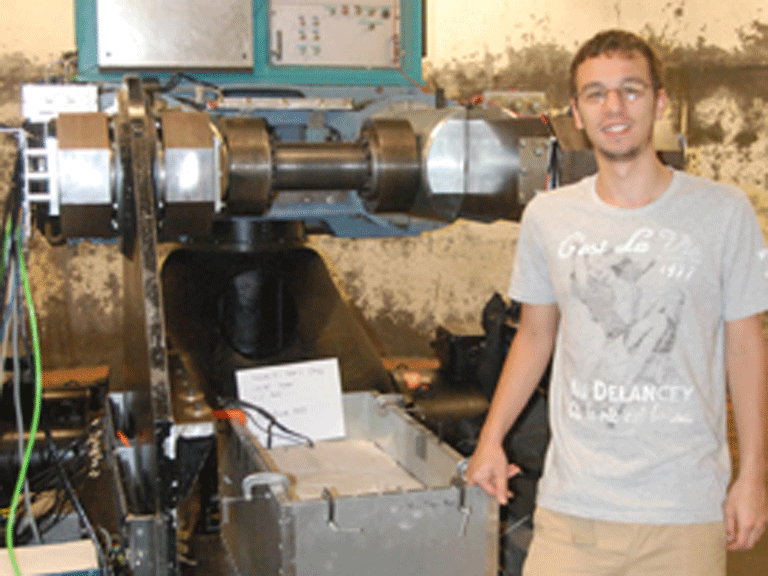 Alberto Morgante ’13 has a pet peeve: not enough politicians have science and engineering pedigrees.
Alberto Morgante ’13 has a pet peeve: not enough politicians have science and engineering pedigrees.
“So many of them come from business and economics backgrounds,” says Morgante, who is majoring in civil engineering. “Nothing against those fields, but how can they truly understand the infrastructure projects they’re funding?”
Morgante recently had an opportunity to educate those politicians himself. On April 24, he traveled to Capitol Hill to present his latest research on how to build bomb-resistant tunnels in a post-9/11 era. Morgante is one of 60 undergraduates across the country selected to participate in “Posters on the Hill,” designed to bring Congressional delegates up-to-speed on some of the most cutting-edge federally funded academic projects. The initiative is sponsored by the Council on Undergraduate Research, a nonprofit organization that fosters collaboration between undergraduates and their professors.
For the past year, Morgante and his adviser, Anirban De, Ph.D., P.E., an associate professor of civil and environmental engineering, have been building miniature models of underground tunnels and, with the help of explosives specialists, they’ve exposed those models to blasts in order to test their durability. The idea is to simulate bomb explosions so future tunnels are built strongly enough to keep commuters and workers safe in the face of a terror attack — an idea that Congressional leaders, especially those representing New York, ought to care about.
The Process
Tried-and-true commuter tunnels like New York’s Lincoln and Holland will always be around, but that doesn’t stop more from being built — consider the Second Avenue subway line, the 7 Train subway extension and the new Grand Central Station cavern for the Long Island Railroad. As America’s urban hubs continue to grow and gentrify, future tunnels will no doubt follow, and in a time of increased terror threat, each tunnel could be subject to attack.
That’s the context under which Morgante and De have exposed their tunnel-models to explosions, which they do at Rensselaer Polytechnic Institute’s (RPI) Center for Earthquake Engineering Simulation in Troy, N.Y.
But the process begins on the home front, in a Manhattan College lab. Morgante and De fasten computer sensors to copper pipes and cover them with concrete and polyurethane in order to resemble tunnels. Next, they place them inside aluminum boxes and bury in varying degrees of sand.
At RPI, lab technicians place explosives on top of the models, then place each one on RPI’s scientifically acclaimed centrifuge, a whirling mechanical wonder that spins objects around in circles like an amusement-park vortex— only insanely faster — in order to increase an object’s heft. The centrifuge spins Morgante’s models at a rate of 150 revolutions per minute, increasing the g-force seventy-fold. A remote button is pressed. An explosion occurs. And Morgante and De take the models back to campus to assess the damage by analyzing the sensor data they acquired during the experiment.
D.C.-Bound
The Posters on the Hill presentation will be staged inside the Rayburn Office Building and attended by any interested Congress members or aides, along with several representatives from Washington-area foundations and funding agencies. Morgante hopes to meet with Senators Charles Schumer and Kirsten Gillibrand, as well as U.S. Representative Elliot Engel.
Morgante, who is from Yonkers, N.Y., will be accompanied by De, who has studied tunnel blasts for 10 years. A former consultant on landfill design for a major San Francisco geoenvironmental firm, De specializes in geoenviornmenal and geotechnical (soil-based) engineering. His current tunnel-blast research is funded by a National Science Foundation grant that grew out of Congress’s 2009 stimulus bill, which allowed De to recruit Morgante last year, along with three additional undergraduate research assistants prior to that.
Ultimately Morgante and De plan to coauthor an academic paper describing their findings. This isn’t the first time he and De have collaborated on a presentation; last month, Morgante presented another set of findings at the 2013 GeoCongress conference in San Diego, which was also open to graduate students. That presentation focused on the strength of torpedo anchors, which are foundations for offshore oilrigs.
Morgante’s selection by the Posters on the Hill committee grew directly out of his frustration with politicians who lack science backgrounds. When he voiced his opinion to De, the Manhattan professor alerted him to Posters on the Hill and encouraged him to apply for it.
Now, says Morgante, all the politicians have to do is listen.
 Alberto Morgante ’13 has a pet peeve: not enough politicians have science and engineering pedigrees.
Alberto Morgante ’13 has a pet peeve: not enough politicians have science and engineering pedigrees.